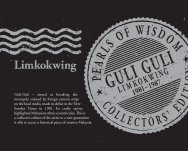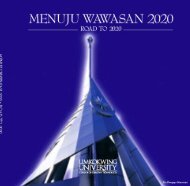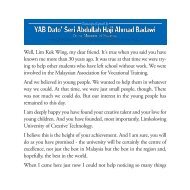INNOVATION LEADERSHIP 1
Innovate the Nation - Limkokwing University of Creative Technology
Innovate the Nation - Limkokwing University of Creative Technology
You also want an ePaper? Increase the reach of your titles
YUMPU automatically turns print PDFs into web optimized ePapers that Google loves.
INNOVATORS TALK STRATEGYINNOVATORS TALK STRATEGYTherefore, strategy equals innovation.If there is no innovationin a company, there is no strategyin that company either.”Govindarajan explained thatsome of the organizations heworked with would place thebulk of their activities in Box 1(i.e. managing the present) andthen declare it as strategy. Whatthey failed to grasp, he said, isthat strategy has nothing to dowith Box 1 activities; it residesentirely in Box 3 (i.e. creatingthe future). Moreover, in orderto create the future, organizationsmust selectively forget pastsuccess so as not to get stuck in aroutine way of solving problems.Therefore, he notes, Box 2 andBox 3 activities are central to innovation.Without such planningand foresight, an organizaioncannot survive in the long-run.Govindarajan also briefly referredto his new book, “ReverseInnovation,” a New YorkTimes and Amazon best-seller,and a concept which wasnamed one of the ten big ideasof the decade by the HarvardBusiness Review. He touchedon how companies are beginningto understand the value ofproducing low-cost/low-valueproducts for emerging markets.This comes in opposition to thetraditional avenue of innovatinghigh-cost/high-value productsfor developed markets and thenscaling those products down overtime to meet the needs of thelower end. His concept of reverseinnovation lined up well withthe overall meeting theme byhighlighting how local insight indeveloping markets have begunto generate sizeable returns forindustry. The fear many industrieshave of cannibalizing highendbrands, he says, is being putto rest as success stories in reverseinnovation gradually emerge.Stereotypes lowerpreparednessTo place these ideas in context,though, several discussionsat the meeting centeredon the rising status of Chinain technology patent filingsand high-end manufacturing.Langdon Morris, Directorof Innovation at PwC, arguedthat knowledge of Chinese philosophyand history has helpedhis firm create better relationshipswith Chinese companies.One of the highest complaintsto stem from doing businessin China is the lack of protectionsurrounding patents. Morrisargues that Chinese culturehandles every business interactionon a case-by-case basis; i.e.getting a feel for the organization’sluster before deciding howto proceed with a venture. Heargues that firms who approachChina with a more solid grasp ofChinese customs and philosophyreceive a more accommodatingwelcome.Jeff Lindsay, Head of IntellectualProperty at Asia Pulp & Paper,in explaining the stereotypes ofChina as a copier, or thief, andnot an innovator, offered a fewOne of the highest complaints to stem fromdoing business in China is the lack of protectionsurrounding patents.The fear many industries have of cannibalizing highendbrands, he says, is being put to rest as successstories in reverse innovation gradually emerge.observations that show thatChina’s business laws are in factchanging.A 2011 study by Thompson Reuterslisted the top 100 globalinnovators and not one of themcame from China. Lindsay thereforebegan to research the subjectand found that Foxconn/HonhaiPrecision, a silent innovationpartner of Apple, actually holdsthree times as many U.S. patentsas Apple.It also has 50 times more U.S.patents as some of the othercompanies on Reuter’s top 100list. He found similar patentholdings by Lenovo and Huawei;both Chinese organizations.He contacted Reuters to makethe necessary corrections andfound them accommodating.Some he spoke with made commentsthat China could not beconsidered a fair subject of innovationexpertise because of thepredominant stereotypes surroundingits business culture.In fairness, he states, China didnot have any patent laws on thebooks until 1984. Since then,however, China has become theworld’s number one patent filerglobally. But many organizationsstick to this stereotype that IP isunsafe in China and refuse todeal with its products or services.What Lindsay argues is that theworld of industry, as a result,is largely unprepared for the opportunitiesChina’s patent filingswill herald. He fears thatmany opportunities may pass usby if we do not adjust to thisreality.“Beyond-the-coreinnovation”The focus on global strategyand execution brought a newcatch-phrase heard throughoutthe duration of the meeting.“Beyond-the-core innovation,”coined by David Edwards earlyon, was integrated into almostevery presentation and conversationwhich took place thereafter.As many attendees agreed, thedays of building an organizationvertically and then outsourcingexternal competencies is fading.Companies are integrating andbuilding horizontal linkagesaround the world. The 2012IRI Annual Meeting, “DrivingGrowth: Here, There, and Everywhere,”was part of an ongoingdialogue about how industryadvances given these globalshifts. It is clear that a new understandingof strategy is required,on-the-ground expertiseis invaluable, and brand cannibalizationfor reverse innovationventures are becoming part of anew normal.It is also becoming apparent thatChina’s rise is not a fluke event,but rather a gradual accelerationof the inherent momentum thatits society is capable of buildinggiven the right conditions.This article is reproduced with kind permission from www.innovationmanagement.se74 <strong>INNOVATION</strong> <strong>LEADERSHIP</strong> <strong>INNOVATION</strong> <strong>LEADERSHIP</strong> 75











